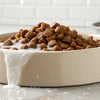How Much Dry and Wet Food for Your Dog: The Ultimate Guide
- Houndsy
Table of Contents
- Introduction
- Understanding Your Dog’s Nutritional Needs
- How Much Dry Food Should I Feed My Dog?
- How Much Wet Food Should I Feed My Dog?
- Mixing Dry and Wet Food: Finding the Perfect Balance
- Addressing Special Dietary Needs
- Treats and Extras: How to Manage Them
- Conclusion
Introduction
Did you know that over 50% of dogs in the United States are classified as overweight or obese? This staggering statistic highlights the importance of understanding how much food we should be feeding our furry friends. As devoted pet owners, we want to ensure our dogs receive the right nutrition tailored to their specific needs. However, with the myriad of options available—dry kibble, wet food, or a combination of both—it's easy to feel overwhelmed.
In this guide, we aim to demystify the question: How much dry and wet food for dogs? By the end of this post, you'll have a clearer understanding of how to determine the appropriate portions for your canine companion, taking into account their weight, age, activity level, and other factors. We'll also explore the benefits and drawbacks of each type of food, ensuring you can make informed choices that promote your dog's health and well-being.
As we delve into this topic, we invite you to reflect on your own pet feeding routines. Are you currently following a consistent feeding schedule? Are you aware of how much food your dog really needs? Join us as we embark on this journey to elevate our dog feeding experiences, ensuring they are both convenient and beneficial. Let’s simplify and enhance the daily ritual of nourishing our pets.
Understanding Your Dog’s Nutritional Needs
The Basics of Dog Nutrition
Before we can tackle how much dry and wet food to feed our dogs, it’s essential to understand the basic nutritional requirements. Dogs require a balanced diet that includes:
- Proteins: Vital for growth, repair, and overall health.
- Fats: Provide energy and support cellular functions.
- Carbohydrates: Source of energy and aid in digestion.
- Vitamins and Minerals: Necessary for various bodily functions.
These nutrients play a crucial role in maintaining a dog’s overall health, vitality, and longevity. The right balance will depend on individual factors such as age, breed, size, and lifestyle.
Assessing Your Dog’s Body Condition
One of the first steps in determining how much to feed your dog is to assess their body condition. A body condition score (BCS) chart can help you visually determine if your dog is underweight, at a healthy weight, or overweight. The scale typically ranges from 1 to 9, with 1 being severely underweight and 9 being obese.
Using a BCS chart, we can categorize our dogs as follows:
- Underweight (1-3): Ribs are easily visible, and there is little to no fat covering.
- Ideal Weight (4-5): Ribs can be felt but are not visible, and there is a noticeable waist.
- Overweight (6-9): Ribs are not easily felt, and there is a significant fat covering.
Weighing Your Dog
To accurately gauge how much to feed our dogs, we first need to know their weight. If you don’t have a scale at home, you can weigh yourself first, then hold your dog and step back onto the scale. Subtract your weight from the total to find your dog's weight.
How Much Dry Food Should I Feed My Dog?
Reading the Feeding Guidelines
Most commercial dry dog foods provide feeding guidelines based on the dog's weight and activity level on the packaging. These guidelines offer a good starting point for determining how much dry food to feed your dog. For instance, a typical guideline might suggest:
- 10-20 lbs: 1-1.5 cups per day
- 20-40 lbs: 1.5-3 cups per day
- 40-60 lbs: 3-4.5 cups per day
Calculating the Right Portion Size
Once you know your dog’s weight and refer to the feeding guidelines, you can adjust the amount based on your dog’s activity level:
- Active Dogs: Increase daily portions by about 10-20%.
- Sedentary Dogs: Decrease daily portions by about 10-20%.
For example, if your 30-pound dog is moderately active and the feeding guideline suggests 2 cups per day, you may consider adjusting the amount to 2.2-2.4 cups.
Transitioning to a New Food
When switching to a new dry food, it's crucial to do so gradually over a week to prevent digestive upset. Start with a ratio of 75% old food to 25% new food, then gradually increase the new food portion each day until you reach 100%.
How Much Wet Food Should I Feed My Dog?
The Benefits of Wet Food
Wet dog food can offer various benefits, including:
- Higher Moisture Content: Helps keep dogs hydrated, especially those who may not drink enough water.
- Palatability: Often more appealing to picky eaters.
- Easier to Chew: Beneficial for senior dogs or those with dental issues.
Determining the Right Amount of Wet Food
Similar to dry food, wet food packaging typically provides feeding guidelines based on the dog's weight. For example:
- 10-20 lbs: 1 can (13 oz) per day
- 20-40 lbs: 1-2 cans (13 oz) per day
- 40-60 lbs: 2 cans (13 oz) per day
When calculating how much wet food to feed your dog, consider the following:
- Mixing Wet and Dry Food: If combining both types, reduce the amount of dry food accordingly. For instance, if feeding 50% dry and 50% wet, you would typically provide half the recommended amount of each.
Example Calculation
Let’s say you have a 30-pound dog, and you want to feed a mix of wet and dry food. If the guideline suggests 2 cups of dry food, you would use 1 cup of dry and adjust the wet food amount based on its caloric content.
If a can of wet food contains 300 calories, and your dog needs 600 calories per day, you could feed 1 can (300 calories) and 1 cup of dry food, which contains approximately 300 calories.
Mixing Dry and Wet Food: Finding the Perfect Balance
Why Mix Foods?
Combining dry and wet food can provide the best of both worlds—moisture and palatability from wet food and dental benefits from dry kibble. This approach can also cater to dogs with specific dietary needs or preferences.
Calculating the Ratio
To effectively mix dry and wet food, you can choose different ratios, such as:
- 50% Dry / 50% Wet: Equal parts of both to provide balanced nutrition.
- 75% Dry / 25% Wet: More emphasis on dry food while still incorporating wet for flavor.
To calculate, simply follow the feeding guidelines for each type of food and adjust based on your total daily caloric needs.
Adjusting Over Time
Monitor your dog's weight and body condition regularly. If you notice weight gain or loss, adjust the portions accordingly. It may take some trial and error to find the perfect balance.
Addressing Special Dietary Needs
Puppies
Puppies have unique nutritional requirements and typically need to eat more frequently—up to five times a day. It's essential to refer to the specific feeding guidelines for puppy food, which often differ from adult dog food.
Senior Dogs
Older dogs may require fewer calories due to a slower metabolism. It’s essential to provide a diet rich in nutrients that support joint health and digestion, often found in specialized senior foods.
Weight Management
If your dog is overweight, consult your veterinarian for a tailored feeding plan. Reducing portions and increasing exercise can help your dog achieve a healthy weight.
Treats and Extras: How to Manage Them
While treats are an excellent way to reward our pets, they should make up no more than 10% of your dog’s daily caloric intake. When calculating how much food to feed your dog, remember to factor in these extra calories from treats.
Conclusion
Understanding how much dry and wet food to feed your dog is crucial for maintaining their health and well-being. By taking into account their weight, activity level, and dietary needs, we can ensure our furry friends receive the proper nutrition they deserve.
As we simplify and enhance our dog feeding experiences, we encourage you to explore innovative solutions like the Houndsy Kibble Dispenser. Designed with convenience and style in mind, our dispenser can help you provide perfectly portioned meals without the mess and hassle.
FAQs
1. How do I know if I’m feeding my dog too much? Monitor your dog’s body condition and weight regularly. If they are gaining weight or becoming lethargic, you may need to reduce their food intake.
2. Can I feed my dog only wet food? While dogs can thrive on a wet food diet, it’s essential to ensure they receive complete nutrition. Always check the feeding guidelines and consult your veterinarian.
3. What should I do if my dog refuses to eat? If your dog is a picky eater, try mixing wet food with dry kibble or warming their food slightly to enhance aroma and palatability. If the issue persists, consult your veterinarian.
4. How often should I feed my dog? Most adult dogs do well with two meals a day. Puppies and certain breeds may require more frequent feedings.
5. Should I change my dog’s food as they age? Yes, as dogs age, their nutritional needs change. Consider transitioning to senior dog food that supports joint health and has fewer calories.
By comprehensively understanding your dog's dietary needs and the right portion sizes, we can ensure that our pets lead happy, healthy lives.












